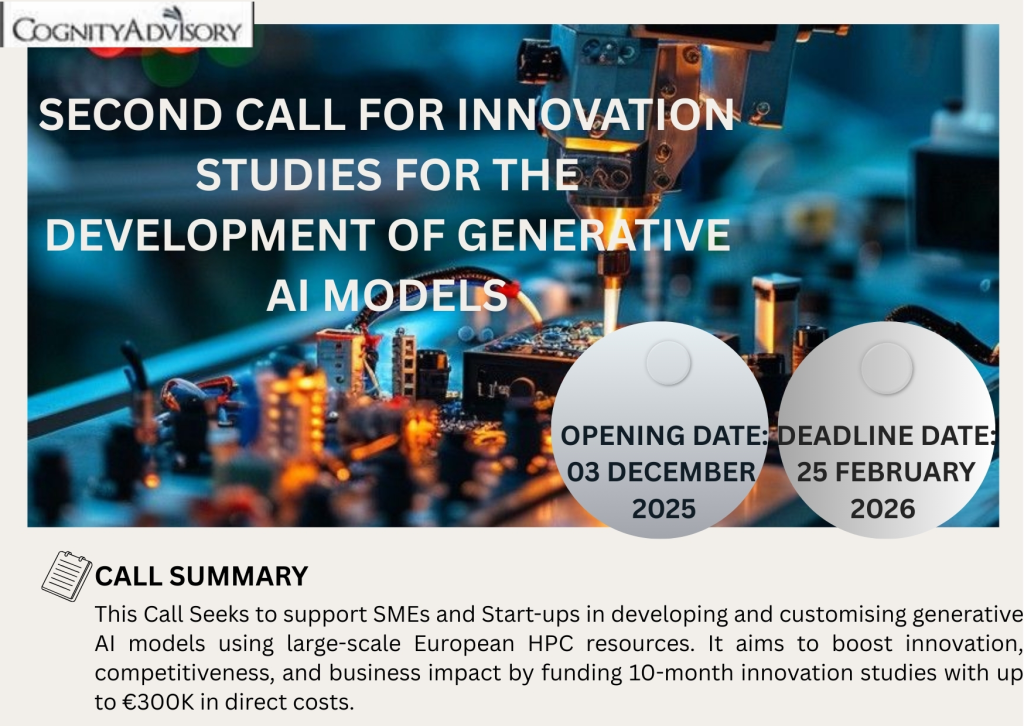FFplus
General Information
Opening date
03 December 2025
Deadline model
single-stage
Deadline date
25 February 2026 17:00 (Brussels time)
Open For Submission
Expected duration of participation
10 months, with targeted commencement July 1st, 2026
Total funding available
4 000 000,00 €
Project acronym
FFplus
Full name of the EU funded project
Fortissimo Plus
Grant agreement number
101163317
Topic
DIGITAL-EUROHPC-JU-2023-SME-01-01 – Supporting competitiveness and innovation potential of SMEs
Submission & evaluation process
All submissions must be made by 17:00 Brussels local time on February 25th 2026.
Proposal submission is exclusively in electronic form using the proposal submission tool accessible via the Fortissimo web-site:
The central component of proposal submission is the uploading of a spread-sheet containing administrative information and a PDF-document (whose size must not exceed 5.0 MB) compliant with the instructions on proposal structure given below.
Proposals must be submitted in English. Each proposal must comprise 2 parts: Part A (containing administrative information), Part B (containing the body of the proposal, the structure of which is explained below).
Part A of the proposal will be submitted as a spread-sheet containing a set of tables to provide administrative data, including a tabular list of proposal participants. The participant list should include for each participant the Participant Identification Code (PIC) issued by the European Commission and valid address, telephone number and email contact data.
(To obtain a PIC, register at
https://ec.europa.eu/info/funding-tenders/opportunities/portal/screen/how-to-participate/participant-register. Please note that having a PIC is not a requirement of the call.)
Only requested information should be included in Part A, conform with the template spreadsheet provided. Additional extraneous information will be deleted before evaluation. Proposers are explicitly requested not to make any changes to the template (e.g. no deletion or renaming of work sheets, rows or columns); major deviations from the template may lead to the proposal being rejected without further evaluation.
The main section of the proposal – Part B – must not exceed 12 pages in length (including any appendices, but excluding the Part B cover page and excluding the provision of scientific literature references). The Part B text should be no smaller than 11-point Arial font; which applies also to images inserted into the proposal that provide textual information. Proposals submitted with a Part B whose length (excluding the cover page) exceeds the 12-page limit will be rejected without further evaluation.
Proposal templates for both Part A and Part B can be found at
It is a requirement that these templates be followed and in particular that the breakdown of the proposal budget be provided using the embedded Excel spread-sheets in Part B. Furthermore, proposals providing inconsistent information in Part A and Part B will be rejected without further evaluation.
The criteria for evaluation will comprise:
- Impact: covering the proposed innovation study’s prospects for innovation, commercial viability and potentially also societal relevance, vision of success and value creation/proposition taking the SME’s business models and exploitation plans into account, alignment with the objectives of the call.
- Excellence: covering both conceptual and technical excellence.
- Conceptual excellence includes conceptual soundness, cohesiveness, and articulation of plans for bridging gaps to ensure successful innovation study implementation and impact.
- Technical excellence includes clear definition of technical requirements, justifying technology choices; articulation of performance metrics for model evaluation, scaling, and optimization; activities for establishing baseline performance and ensuring experiment reproducibility.
- Implementation: covering the quality of the project’s workplan and data management plan, the distribution of resources to additional organisations (where applicable), capacity of the applicant(s) to carry out the proposed work, the justification for computation resources required.
Each criterion will be assigned a score between 0 and 5. The overall acceptance threshold (summed over all criteria) is set to 10, while a minimum score of 3 must be achieved for each criterion. All criteria are equally weighted. However, in case of a tie in the overall score ranking, proposals are ranked based on the individual criteria scoring applying the following priority: Impact, Excellence, Implementation, and finally total requested funding.
